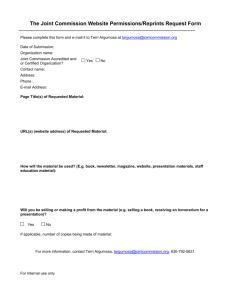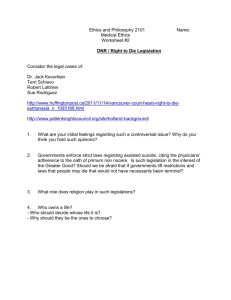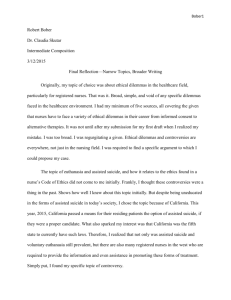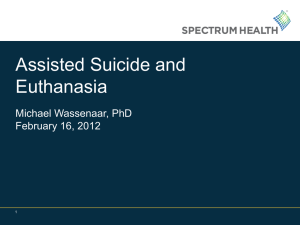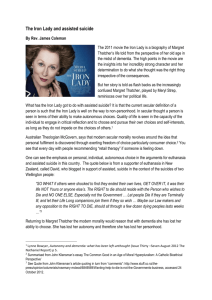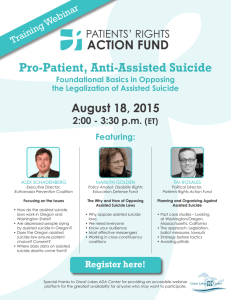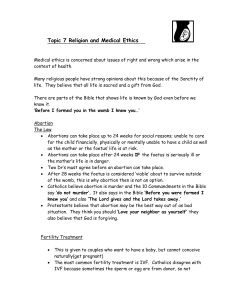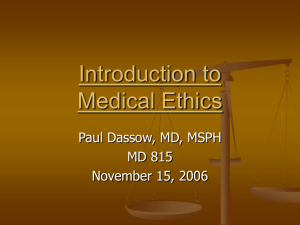lesson 2
advertisement
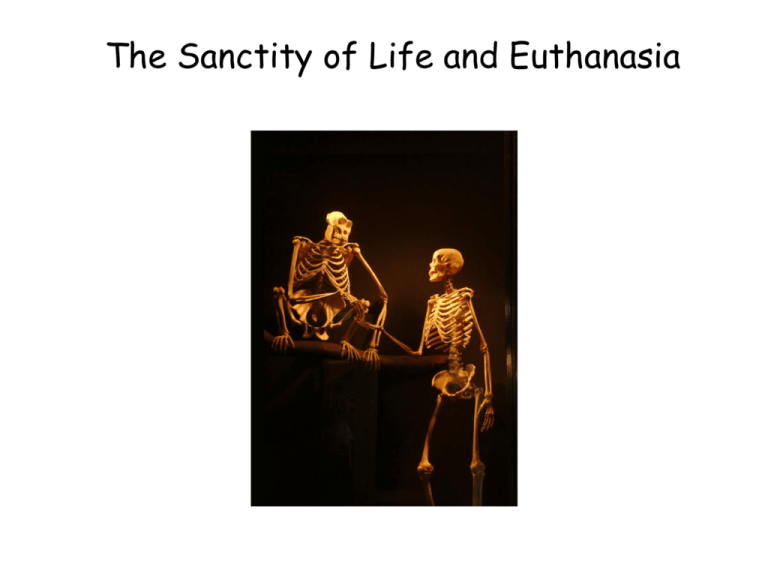
The Sanctity of Life and Euthanasia Title: Introduction to Euthanasia L.O. What are the main issues? • • • • • • • • • 80 year old doctor 12year old boy 40 year old army sgt. Pregnant woman Stephen Hawking Cheryl Cole Barack Obama 28 year old AIDS sufferer Buddhist Monk Why are these principles being challenged today? • Human life is said to be intrinsically valuable (the Latin word ‘sanctus’ means ‘sacred’, ‘inviolable’, ‘holy’): 1. It is wrong intentionally to take an innocent human life. 2. All human lives are of equal value, irrespective of age or condition. 3. In medical ethics, a moral distinction is made between intentional killing, which is regarded as morally wrong, and allowing a patient to die when further treatment is seen as futile. • These principles may be based on Biblical perspectives (for example, the doctrine of Imago Dei – human beings as created ‘in the image of God’). Challenges to the Sanctity of Life Ethic • The decline of religious authority and belief in divine creation • The belief that human beings should have autonomy – the right of self-government (the right to choose between life and death). • Since Darwin, we have become more aware of our kinship with other animals. • It is possible to prolong life without guaranteeing quality of life • Advanced medical technology has blurred the boundaries between life and death. • Some philosophers argue that we should distinguish between the biological category ‘human being’ and the psychological category of ‘person’. They argue that ‘person’ rather than ‘human being’ is the morally significant category. Peter Singer: Practical Ethics • ‘The fact that a being is a human being, in the sense of a member of the species Homo sapiens, is not relevant to the wrongness of killing it; it is, rather, characteristics like rationality, autonomy and selfconsciousness that make a difference’ • In Re-thinking Life and Death, Singer argues that the re-definition of death actually involves a ‘quality of life’ judgement. • He believes the same is true of the decision to remove artificial feeding from Anthony Bland. Singer’s ‘Five New Commandments’ Five old commandments 1. Treat all human life as of equal worth. 2. Never intentionally take human life. 3. Never take your own life, and always try to prevent others taking theirs. 4. Be fruitful and multiply. 5. Treat all human life as always more precious than any non-human life. Five new commandments 1. Recognise that the worth of human life varies. 2. Take responsibility for the consequences of your decisions. 3. Respect a person’s desire to live or die. 4. Bring children into the world only if they are wanted. 5. Do not discriminate on the basis of species. Immanuel Kant • Kant believed that human beings deserve absolute respect because they have rational autonomy. This is what makes human beings Godlike. • Unlike rocks and thunderstorms, human beings have the ability to think and decide for themselves what they will do. • Treating someone no differently than we would an object (as a means to an end) is to act immorally and irrationally. Jeremy Bentham (1748-1832) • “The question is not, Can they reason? Nor, Can they talk? But, Can they suffer?” • Bentham denies the Kantian view that rational autonomy is the basis of our moral standing. He argues that what matters is the ability to experience pleasure and pain. On his view, pleasure is intrinsically good and pain is intrinsically bad. The world is better when there is additional pleasure and worse when there is more pain, and it doesn’t matter who or what is having that experience. Dr Jack Kervorkian Dr Jack Kervorkian is well known in the United States for his practice of assisted suicide. In 1990 he assisted Janet Adkins to die. Since then he claims to have assisted in over 100 deaths. He has been tried three times by the US courts and acquitted in all three cases by juries. However, recently he escalated his practice from assisted suicide to direct mercy killing in the case of Thomas Youk, who suffered from amyotrophic lateral sclerosis. He prepared a video showing his every action and the exact moment of Youk’s death, and appeared with the video on a national television news programme, daring the authorities to prosecute him. He was brought to trial and convicted on charges of second-degree murder. • Did Dr Kevorkian do the right thing? • Give your opinions with reasons. Euthanasia and the Law in the UK Euthanasia “When life is taken deliberately, the appropriate charge is murder. Thus, if a doctor responds to a request from a patient to end his life and administers a lethal injection, the doctor will have acted with the necessary mens rea for murder (mens rea is the mental element required for conviction of a crime. It makes no difference from the legal point of view that the patient gave their consent. Consent is no defence to a charge of murder, or indeed to the infliction of any substantial physical injury on another. Nor does the doctor’s motive make any difference; the fact that this was a case of ‘mercy killing’ does not affect the status of the act as one of murder …” Withdrawing treatment “The criminal law does not require doctors to persist in the treatment of a patient when no medical purpose is served by such persistence” Assisted Suicide In England, suicide was a crime until the passage of the Suicide Act 1961. This legislation decriminalised suicide (which could obviously only be prosecuted as an attempted crime), but retained the criminal prohibition of aiding and abetting suicide. This means that a doctor who responds to a direct request of a patient to prescibe drugs which he knows the patient intends to use to take his life will be committing an offence under this statute … It is certainly the case that suicide has not been a crime in Scotland – at least in modern times – and, therefore, it is difficult to see how there could be a conviction for being art and part guilty (the Scottish term for accomplice liability) to a non-existent crime. This does not preclude, however, charging a person who assists suicide with a common law crime, such as that of recklessly endangering life. (Alexander McCall Smith, British Medical Bulletin, 1996) Around the world • The only four places that today openly and legally authorize active assistance in dying for patients, are: • Oregon (since l997, physician-assisted suicide); • Switzerland (1941, physician and non-physician assisted suicide); • Belgium (2002, permits 'euthanasia’); • Netherlands (voluntary euthanasia and physician-assisted suicide lawful since April 2002 but permitted by the courts since l984). • • • • • • Each of the following conditions must be fulfilled: The patient’s suffering is unbearable with no prospect of improvement. The patient’s request for euthanasia must be voluntary and persist over time (the request cannot be granted when under the influence of others, psychological illness or drugs) The patient must be fully aware of his/her condition, prospects and options. There must be consultation with at least one other independent doctor who needs to confirm the conditions mentioned above. The death must be carried out in a medically appropriate fashion by the doctor. The patient is at least 12 years old (patients between 12 and 16 years of age require the consent of their parents) This is Terri Schiavo. She died in 2005 after a long legal battle between her husband and her parents. This photo was taken in 1990, shortly after a chemical imbalance caused Terri's heart to stop beating, cut off oxygen to her brain and left her severely braindamaged. Terri was in a vegetative state for 15 years. In this photo she gets a kiss from her mother, Mary Schindler. Terri's husband, Michael Schiavo, says she told him once that she would not want to be kept alive artificially. He attempted to get Terri's feeding tube removed for seven years, after he came to believe that she would never recover. Under American law Terri’s husband was her legal guardian. Bob and Mary Schindler, Terri's parents, went to court to try to fight Michael’s efforts to let her die. Demonstrators cover their mouths with tape, which they say represents the silencing of Terri Schiavo, in a protest outside the hospice where Terri was a patient. Terri’s feeding tube was removed on 18th March 2005. She died 13 days later. During this time her parents continued to try to get the legal decision to remove her feeding tube overturned. Terri Schiavo 1963 – 2005 Terri spent the last 15 years of her life connected to a feeding tube in what doctors described as a persistent vegetative state. Paired Task Part 1 • In pairs discuss these points. Write the answers in your jotter 1. Why did her husband want to remove the feeding tube? 2. Why did her parents not want it removed? 3. “You saw a murder, all who denied her right to live are accomplices.” what does this statement mean? 4. Do you agree with it?, explain your answer. Individual Task • Put a title “Case Study: Terri Schiavo” and then answer these questions as fully as you can. 1. Apart from Terri herself, who else was affected by this case? Make a list. How far do you think that the views of the people on your list should have be taken into account? Explain. 2. Do you think that the decision that was finally made (withdrawing Terri’s feeding tube) was the right decision? Give reasons. 3. Think about how the decision was made. Do you think that the courts should decide cases like this? Give reasons. BMA Guidelines • In 2006, BMA members voting at the annual meeting made clear that the majority oppose euthanasia legislation. • The BMA’s policy is that assisting patients to die prematurely is not part of the moral ethos or the primary goal of medicine and, if allowed, could impact detrimentally on how doctors relate to their own role and to their patients. • Although the BMA respects the concept of individual autonomy, it argues that there are limits to what patients can choose if their choice will inevitably impact on other people. • If assisted dying were an option, patients might feel obliged to choose it for the wrong reasons, such as if they were worried about being a burden or concerned about the financial implications of a long terminal illness. • The concept of assisted dying could weaken society’s prohibition on intentional killing and undermine safeguards against non-voluntary euthanasia of people who are both seriously ill and mentally impaired. • An urgent and continuing matter of concern remains the uneven availability of good quality palliative care. In 2005, the House of Lords Select Committee on the Assisted Dying for the Terminally Ill Bill was critical of the gaps in palliative care provision. The Principle of Double Effect • The principle of double effect makes a distinction between deaths that are directly intended and deaths that are merely foreseen. • It is not permissible for a doctor to administer a large dose of morphine with the intention of hastening death. • It is permissible for a doctor to administer a large dose of morphine with the intention of relieving pain (if that is the only way to relieve pain), even if they foresee the hastening of the patient’s death. • If safer drugs were available, they would be used: pain would be controlled and life would not be shortened. Peter Singer ‘… membership of the species Homo sapiens is not a reason for giving a being worse treatment than a member of a different species …We do not doubt that it is right to shoot badly injured or sick animals if they are in pain and their chances of recovery are neglible. To ‘allow nature to take its course’, withholding treatment but refusing to kill, would obviously be wrong. It is only our misplaced respect for the doctrine of the sanctity of human life that prevents us from seeing that what is obviously wrong to do to a horse, it is equally wrong to do to a disabled infant.’ ‘Slippery Slope’ Arguments • In its logical version, the ‘slippery slope’ argument is unconvincing. As Helga Kuhse argues, there are no logical grounds why the arguments for euthanasia – mercy and respect for autonomy – should also justify killings that are neither merciful nor show respect for autonomy. • However, as a reflection on human nature it may be more plausible – e.g., once people have one thing, they will always demand more.
